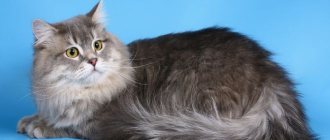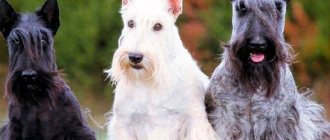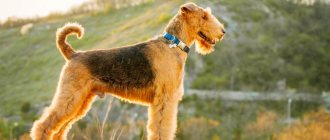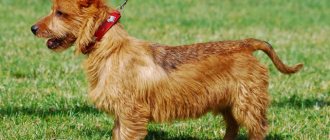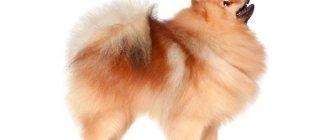The West Highland White Terrier is a breed of hunting dog developed in Scotland. It is quite ancient and has long been used for hunting small burrowing animals. Despite its small size, this dog is active, efficient and courageous. She is now popular as a companion due to her peaceful nature and cheerful disposition. Before getting a West Highland White Terrier, it is worth studying the description of the breed and a video about it. Reviews from the owners will help you learn about its character, pros and cons of its content.
- Head
- Education and training
- Grooming
History of the West Highland White Terrier breed
West Highland White Terrier
The West Highland White Terrier is a fairly ancient breed, so there is not as much reliable information about its origin and development as we would like. The few written sources from the Middle Ages claim that the ancestors of today's West Highlands successfully hunted small animals back in the 12th century. At the same time, modern researchers are sure: the true history of this variety of terriers began at least several centuries earlier.
The homeland of the West Highland White Terrier is considered to be western Scotland with its rocky ridges and minimalist mountain landscapes (West Highland from English - western highlands). It was here that the small but tenacious shaggy creatures revealed their hunting potential, pulling otters out of rock crevices and digging up badger holes. What is interesting: at first, West Highland White Terriers had a wider palette of colors, ranging from fawn to brindle varieties. But in those ancient times, individuals with white fur were not valued, as they were considered too sickly, so owners tried to get rid of all white puppies in the litter.
The breed owes its current appearance to two eminent Scots who lived at the turn of the 19th and 20th centuries - Colonel Edward Malcolm and the 8th Duke of Argyll, George Campbell. Both gentlemen approached the issue of breeding animals innovatively, starting to select and in every possible way promote white-haired Westies. Well, since in those days the name West Highland White Terrier had not yet been assigned to the breed, the colonel’s charges were dubbed Poltalloch Terriers (after the name of the estate in which they were bred), and the Duke of Argyll’s pets were called Rosenet Terriers.
The first club for fans of the West Highland White Terrier breed opened in Scotland in 1904, and its founder was a descendant of that same George Campbell. Quite soon, or more precisely, three years later, the first nursery, specializing in breeding snow-white Westies, began its activities. However, it was possible to put an end to the formation of the unique exterior of the breed only in 1924, after breeders were officially prohibited from exhibiting at exhibitions dogs whose pedigree included other representatives of the terrier group (Scottish terrier, Cairn terrier).
Appearance of the West Highland White Terrier
West Highland White Terrier puppy
The West Highland White Terrier is a snow-white, compact shaggy dog with an inquisitive look, vaguely reminiscent of a Bichon Frize. Thanks to their sweet appearance and more than modest dimensions (the height of an adult dog is up to 28 cm, weight is up to 10 kg), West Highlands are quite suitable for the role of apartment dwellers. At the same time, they are not particularly fragile, like most representatives of decorative breeds, which means the owner does not have to control every step and jump of the pet.
Head
The skull of the West Highland White Terrier is wide, slightly convex, with a pronounced stop and prominent brow ridges.
Jaws and bite
Despite the fact that the West Highland White Terrier is an almost miniature dog, its jaws are powerful. As for the bite, representatives of this breed have a full, scissor-type bite.
Eyes
The wide and fairly deep-set eyes of the West Highland White Terrier have an almond shape and a dark iris color. The dog's gaze is intelligent and insightful.
Nose
The Westie has a large, black nose, which almost does not protrude beyond the muzzle.
Ears
The West Highland White Terrier's small, pointed ears are not set too wide and are carried straight. The outer side of the ear is covered with velvety fur, which is never cut.
Neck
Dogs have a moderately long and well-muscled neck, which gradually thickens towards the body.
Muzzle to lead
Frame
Great guy
The body of representatives of this breed is compact, with a straight back, strong lumbar region and wide croup.
Limbs
The front legs of the West Highland White Terrier are short, well muscled and without curvature or turning outward. In some cases, the animal's paws may be slightly turned out. Experts explain this feature by the fact that during the hunt, the ancestors of today's dogs tore up the ground, throwing it to the sides, which caused the slight spread of the limbs. The hind legs of the West Highland are short but sinewy, with a fleshy and broad upper part. Dogs' paws are round, with plump pads and tightly knit toes, with the front paws being noticeably larger than the hind paws.
Tail
The Westie has a straight tail up to 15 cm long, which it carries almost vertically.
Watching the rain
Wool
The West Highland White Terrier's coat consists of a dense furry undercoat and coarse outer coat, the length of which can reach 5 cm.
Color
The West Highland White Terrier is one of those few breeds, modern representatives of which exist in one single color - white. An important point: the color of the wool is extremely unstable and very dependent on external factors, so among animals there are often individuals whose “fur coats” have a yellowish tint.
Defects and disqualifying defects
Any more or less noticeable deviations from the standard can affect the exhibition assessment of show-class West Highland White Terriers. These are usually wavy or curly fur, large ears, a short or, conversely, excessively long neck, and atypical position of the limbs. As a rule, a dog may not be allowed to participate in competitions for two reasons: for displaying causeless aggression or cowardice, as well as for obvious defects in behavior and physical development.
Disqualifying faults
The West Highland White Terrier dog breed is removed from the ring for any defects in appearance that significantly deviate from the standard. Among the possible defects:
- barrel ribs;
- X-shaped position of the limbs;
- wool with waves or curls;
- long (swan) or short (bull) neck;
- feathering, fringe on the ears or tail.
All these shortcomings affect the assessment. Whether to disqualify a pet is decided based on the severity of the defect and its effect on the dog’s physical health.
Serious behavioral shortcomings - cowardice, aggression. Pets are culled for them.
Photos of West Highland White Terriers
Character of the West Highland White Terrier
West Highland White Terriers are white and fluffy on the outside only. Inside, these charming “Scots” are far from being such good boys as they seem at first glance; moreover, they are quite stubborn and do not really like to obey the chain of command. At the same time, compared to their more aggressive and temperamental relatives in the terrier group, West Highland White Terriers seem, if not quite quiet, then quite manageable pets. However, this is not an innate advantage, but rather the result of the work of breeding specialists, who for a long time “extinguished” the hunting instincts of the breed and stimulated its companion qualities.
Lead with your owner
All West Highland White Terriers do not like to be ignored, and these snow-white babies do not cope well with loneliness. So before you bring a young messenger into your home, think about whether you are ready to sacrifice silence and your own peace for the sake of a four-legged nimble. West Highland White Terriers have a partnership-like relationship with children: they enjoy playing together, while both parties taking part in the process feel equal. It’s another matter if the dog has to deal with kids who, due to their thoughtlessness, can annoy it with intrusiveness or cause pain. In this case, the news will definitely fight back (guess in what way).
The West Highland White Terrier can easily delegate guard duties. Most representatives of this breed have acute hearing and are able to warn the owner about the appearance of a stranger with a ringing bark. At the same time, they do not experience any particular hostility towards strangers, which means they will not frighten your guests with sudden attacks and dissatisfied grumbling.
Despite all the efforts of breeders, the specialists in burrow hunting in West Highland White Terriers have not completely died out, so from time to time the dogs will be drawn to feats. In particular, on walks, Westies will selflessly dig trenches in search of an imaginary gopher, and when they see a garbage rat or some other small animal, they will immediately rush into battle. Treat this pet behavior with slight irony: after all, every breed has its own harmless cockroaches.
West Highland White Terrier and cat
Suitable nicknames for Westies
The nicknames for West Highlands are special. These are just white and fluffy dogs. In fact, they have a noble, brave, somewhat capricious character. Therefore, ordinary names for small breeds will not be suitable for Westies.
Breeders themselves choose the names for the puppies - for each litter they begin with the same letter and contain a prefix with the name of the kennel. But they are long and awkward to pronounce. Therefore, kittens are often baptized at home - by shortening the nickname from the pedigree or inventing their own.
| Names suitable for boys | Nicknames for girls |
| Zeus | Bernie |
| One | Valkyra |
| Tim | Xena |
| Brock | Moran |
| Hercules | Esmeralda |
| Tank | Alva |
| Jed | Sheila |
| Kurt | Lorita |
| Asterix | Cecile |
| Daron | Mirli |
| Shelby | Regina |
| Ralph | Scarlett |
| White | Iris |
| Leon | Ashley |
| Prometheus | Ariel |
| Cody | Laura |
| Gabi | Carol |
| Dean | Nola |
| Badi | Verna |
Education and training
High five!
A West Highland White Terrier will never follow the commands of someone it doesn’t respect and considers obviously stupider than itself, so the first thing you should start training a dog with is asserting your own authority. In addition, the pet will have to be constantly stimulated, since this is not a breed that will work on sheer enthusiasm. If your charge has successfully completed the command, appease him with a tasty treat, and then give him a play break - West Highland White Terriers love to rage aimlessly and fool around no less than they love to hunt. By the way, about games: from the very first days, let your pet understand that practicing hunting skills on the owner and other family members is strictly prohibited. If your angry West Highland White Terrier still tries to taste your hand or foot, gently redirect his attention to the toy.
Important: while training and practicing commands, try to remain alone with your pet. The presence of strangers only slows down the training process, since it is more difficult for a dog to concentrate if two people are communicating with it at the same time.
You should accustom your West Highland White Terrier puppy to a collar and leash before going on its first walk. To do this, buy a one and a half to two meter strap and an unfastening collar with a lock, which will not need to be put over the head, thereby frightening the animal. Once your Westie is 10 months old, you can train with him on the playground. It is better to enroll difficult-to-train and particularly stubborn individuals in some kennel club, where an individual training program will be selected for them, and their behavior will also be adjusted.
If you don’t want your time together with your West Highland White Terrier to turn into a “who will win” confrontation, pay special attention to teaching your pet basic norms of behavior. In particular, do not let the Westie lie on your bed and do not let him look with hungry eyes at the family members gathered at the table. And there are no exceptions to the rules or concessions: despite the external weakness and fragility, the West Highlands are simply masterful at twisting the rope out of the owner.
West Highland White Terrier in a basket
Westie goes through an obstacle course
Hunting with a West Highland White Terrier
As noted earlier, it is not customary to go after foxes and badgers with today's West Highland White Terriers. Moreover, at competitions and exhibitions, representatives of this breed have long been evaluated exclusively by external parameters and almost never by working qualities. On the other hand, no one has the right to prohibit the owner of a West Highland White Terrier from going with his ward to hunt the animal. So if you are eager to try out your pet in action, sign up for any kennel club that has a training hole, and practice your pupil’s hunting talents as much as you want. As practice shows, people are extremely reckless in their work, but at the same time they do not lose their minds. In addition, they very quickly learn the habits of a wild animal and can change tactics at lightning speed if the situation requires it.
Application
The West Highland can still go hunting with you.
You can read about other hunting breeds here:
Sensitive hearing and a ringing voice make the West an excellent watchman - he will immediately inform you of any incident with a loud bark.
With Westies you can engage in active types of dog sports, keep him just “for fun” and for long walks in good company.
Westies make good hunters
Maintenance and care
Every year, West Highland White Terriers are increasingly turning into indoor/sofa pets, and the reason for this is the desire of the owners to keep the soiled “fur coats” of their charges relatively clean. However, by nature, Westies are not such sissies and are quite capable of spending time outside, even if the weather leaves much to be desired. Bright, cute clothes and blankets, which West Highland White Terriers are often dressed in, are by no means a forced measure, but rather the owner’s desire to emphasize the uniqueness of his pet. In reality, West Highland White Terriers do not suffer much from the cold even in the winter months, provided, of course, that you do not keep the dog outside all day.
Combing wool
Grooming a West Highland White Terrier
Nail cutting
Trimming and cleaning the coat of the West Highland White Terrier
Well groomed West Highland dog at a dog show
A pleasant bonus for fans of sterile cleanliness: West Highland White Terriers do not shed and have virtually no odor. Of course, the coat of animals is regularly renewed, but dead hairs from their “coats” do not fall out, but simply fall off. Accordingly, in order to maintain the pet’s image, it will have to be trimmed once every couple of months or, if it is a show dog, every 30 days. Grooming is prohibited for these charming shaggy dogs, as it changes the structure of the coat, softening it and causing the hair to curl into a curl. As a result, the West Highland White Terrier loses its original appearance and becomes like a hybrid of a lapdog and a Bichon Frize. However, if you are not ambitious and do not plan to go to exhibitions, you can try to cut your ward’s hair. Your self-esteem will not suffer from this at all.
Before trimming, the West Highland White Terrier is thoroughly combed, after which the throat area and the area at the elbows are treated as briefly as possible with a stripping knife. The line from the withers to the croup, as well as the ridge of the neck, is also pinched with a knife, maintaining a total length of fur of 4-5 cm and smoothing out the transitions. As an example: an exemplary West Highland White Terrier should have short hair on the sides and a so-called skirt - lush, adorning hair on the chest. The hair on the forehead, crown and cheekbones is plucked by hand (placking technique), giving the head the shape of a chrysanthemum. The hair on the legs is usually not shortened.
If you want to preserve the unique snow-white color of the West Highland White Terrier, be prepared to spend an extra hour and a half on your pet’s “fur coat.” The fact is that the fur of representatives of this breed often turns yellow when dog saliva or food gets on it, so to neutralize the unwanted undertone it is necessary to use a cleaning composition of crushed chalk and boric acid. The mixture is rubbed into slightly moistened wool, after which its chalky particles are combed out with a regular hair brush.
Hygiene
Once a month, West Highland White Terriers are bathed using diluted pet shampoo (conventional products are not suitable). Not the most useless purchase is a whitening shampoo, which allows you to preserve the exquisite shade of the Westie's coat. Just don’t test it on a puppy, otherwise you risk seriously damaging the baby’s hair structure. Otherwise, representatives of this breed are suitable for any detergent compositions designed specifically for wire-haired dogs.
Hello!
Once every 5-6 days, the West Highland White Terrier should be combed with a sparse comb with metal teeth, which will not tear the undercoat, but will only gently remove dead hair and debris. But this is only if the pet’s coat is tough and healthy. Individuals with soft fur will have to be combed more often, otherwise you will get tangles. In addition, do not forget to wipe your dog’s face with a napkin after eating so that food debris does not get stuck in the fur and cause a change in its color.
Once a week, you need to pay attention to your ears: pluck out long hair that interferes with the free circulation of air inside the ear funnel, and remove dirt accumulated in the ear shell. It is best to examine the West Highland White Terrier's eyes every day. If brown streaks are found on the fur under the lower eyelids, the dog most likely has an allergy, so grab your pet and run to a veterinarian for a consultation. Westies have their teeth brushed a couple of times a week. In addition, it is useful to introduce various solid foods into the dog’s diet, particles of which act as abrasives and partially remove plaque. The paws of the West Highland White Terrier also need care, so after each walk they should be washed thoroughly, and in winter, when the roads are sprinkled with reagents, they should also be lubricated with vegetable oil.
Walk
If your West Highland White Terrier does not hunt (and he most likely does not hunt), he will have to compensate for the lack of adrenaline and positive emotions with walks and training. Westies must be taken outside at least twice, or preferably three times a day, and this should not be a 15-minute run around the playground. The first walks begin at 3 months of age, after the puppy has undergone routine vaccination and spent a week in quarantine. By the way, up to 6 months, babies are taken outside (they are taken out, not taken out) 5-6 times a day, which is due to the need to develop in them the ability to relieve themselves outside the home.
Westies love to rummage in the ground and are capable of destroying a well-groomed flowerbed or green lawn in a matter of minutes, so if you don’t want to constantly argue with landscape designers and utility workers, it’s better not to let your pet off the leash within the city. When walking with a West Highland White Terrier in nature, it is also better not to lose vigilance. Firstly, because dogs intoxicated by unfamiliar smells and sounds instantly become difficult to control. And secondly, because the Westies have a real passion for carrion, in which they prefer to wallow thoroughly before responding to the owner’s command.
West Highland White Terrier on a walk
Feeding
Who do you take me for?
The diet of the West Highland is not much different from the menu of its other terrier brothers. In particular, half of the dog’s meal should consist of lean meat, which is supplemented with vegetables (broccoli, pumpkin, turnips), cereal porridge (rice, buckwheat), fermented milk products and fruits. However, since most dogs are prone to food allergies, menu planning should be approached with the utmost caution and preferably with the involvement of a veterinarian.
Once and for all, eliminate chicken and wheat from your West Highland White Terrier's diet. The same rule applies to industrial feed. If you find wheat flour and “chicken” in the store-bought “drying”, return this product to the shelf and never look at it again. As for vitamin supplements, you can periodically add crushed greens (nettle, dandelion, parsley), brewer's yeast and salmon oil to the food of West Highland White Terriers. Once a week it will be useful to treat your fluffy with a quail egg, and during the season you can pamper him with half an apricot, a piece of pear or a ripe plum. By the way, despite the fact that sweets are strictly prohibited for West Highland White Terriers, dogs are simply crazy about them. So when you're ready to enjoy some ice cream or candy, don't forget to hide well from the four-legged beggar.
Please note: the West Highland White Terrier's coat may change color and acquire a yellowish tint if the dog's diet includes foods containing artificial or natural dyes. For pets this is not critical, but for show-class animals such changes can seriously spoil their exhibition career.
Westie enjoying the sunset
Health and Diseases of West Highland White Terriers
West Highland White Terriers live an average of 13-15 years and are less prone to hereditary diseases than their terrier counterparts.
Diseases that may occur in West Highland White Terriers:
- cranial osteopathy;
- atopic dermatitis;
- epidermal dysplasia;
- ichthyosis;
- congenital deafness;
- hip dysplasia;
- diabetes;
- von Willebrand disease;
- cardiovascular diseases;
- meningoencephalitis of white dogs;
- Perthes disease;
- Shaker syndrome;
- hyperuricosuria.
Mating
This breed is quite rare; most often the mating is for breeding and official purposes. Puppies reach puberty at 8-10 months: bitches begin to go into heat, and males begin mating. But you can only knit by 20 months . The most optimal time is 13-15 days from the start of the girl’s estrus.
Signs of a female's readiness:
- Swollen loop;
- Light discharge;
- Playful behavior.
The dogs are first introduced and walked together the day before mating. At the appointed time, the girl is brought to the dog’s territory, where the act should take place. It will last no more than 20 minutes , but pets can stay in the castle for a long time. It is important to choose a comfortable position for the animals in which they cannot be injured.
For the first time, it is customary to invite a specialist who will tell the owners what to do, guide the dogs and help them. Before mating, it is necessary to check pets for pathologies and carry out a deworming procedure.
How to choose a puppy
- Choose reliable, proven nurseries registered by the RKF. Usually all matings in them are planned.
- Give preference to breeders or nurseries who are ready to provide their clients with advisory support throughout the entire period of the puppy’s growing up. Unscrupulous “breeders” whose main goal is to make a profit from the sale of animals, as a rule, do not make such concessions.
- If possible, look at several litters. Offspring from different parents can differ significantly in both external and behavioral indicators.
- The gender of the West Highland White Terrier has virtually no effect on its temperament type and intellectual abilities, although it is believed that males of this breed learn faster than females.
- Assess the level of hygiene and living conditions of the puppies in the kennel. It’s great if the kids don’t sit in dirty cages, but move freely around the territory allotted to them.
- Touch the belly of the puppy you like. If additional swelling is felt in the navel area or there is bulging of the peritoneum, there is a possibility that the baby will be diagnosed with a hernia in the future.
- Responsible breeders test West Highland White Terriers for the presence of genetic diseases, so before purchasing, do not be lazy to read the results of the test, so that later you will not be surprised why your baby has health problems.
Dog food
There are as many opinions as there are owners, but basically everyone adheres to one of two things:
- “human” food, namely porridge, chicken, vegetables, some fruits, etc. Please note that the food must be fresh, unsalted and cooked specifically for your dog.
- dry and/or canned food from different manufacturers. Each Westie, like a person, will suit a certain brand of food. You can understand this only by your own example.
Yes, many owners of this breed agree on one company, but no less prefer another. Not only your pet’s well-being, activity and mobility, but also the color and pigmentation of its coat depends on food.


